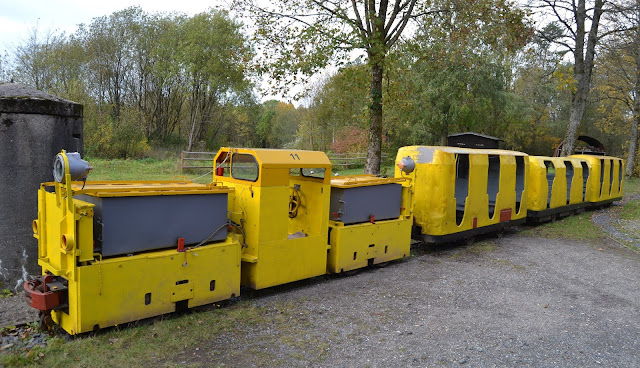My early Christmas present for myself arrived the other day: 6 skips to enhance the carrying capacity of my 1/19 scale gravel line. The skips are of the German type in very widespread use in Denmark. In contrast to the British Hudson type that was only used by very few Danish industries.
 |
| Three new skips ready for a test run on some of Nystrup Gravel's temporary track. |
 |
| A view from Mønsted Chalk Works in the 1950's. The skips are a mix of British Hudsons and German types. As countless German companies made V-skips of the same type regulated under the German 'Deutsche Institut für Normung', it's usually not easy to distinguish one company's product from another. Cropped image from Arkiv.dk |
I have again been taking advantage of the falling value of the British pound in relation to the Euro. Consequently every item I have purchased from the UK in the last few months have been almost 20% cheaper than if I had shopped in e.g. 2015. I bought the skips on eBay and being the only bidder I got away with paying the minimum price set by the seller. The price for each skip consequently compares favourably with a new freight wagon in H0. Large scale railway modelling doesn't have to be expensive.
The skips are made in South Korea by Lik Enterprise Inc. for a US company called Car and Locomotive Shop to 1/19.2 scale. At least that is the scale printed on the small label on the box. Skips and a LKM NS2f loco from the same company were reviewed in Narrow Gauge and Industrial Railway Modelling Review 57.
The skips arrived very professionally packed. Skip frame complete with wheel sets and skip body were separately packed in a zip lock plastic bag. Each of these were inserted into custom made foam shapes, keeping the skip parts safely in place in their solid cardboard box. In the box were also a small bag with two sets of coupling chain, each with 3 links and a small bag with moisture absorbing material.
 |
| New skip of German DIN 0.75 m³ type just out of the box compared with a Hudson 'Rugga' type. |
With a length of 91,5 mm, a wheel base of 31 mm and a height of the skip body of 37 mm the 1/19 model correspond reasonable well with the measurements of a Orenstein & Koppel skip from 1949. The skips are well assembled and the surface is completely smooth with no trace of solder, file marks or other imperfections. The paint is well applied and small details like rivets show up nicely.
 |
| Drawing of DIN skip from Orenstein & Koppel dated 1949. The skip is of 'Leichte Bauart' a light version without e.g. a central steel profile providing lengthwise stability. For long trains and mechanical traction the light skip wasn't considered durable enough. My 16 mm scale skips have the central frame beam. |
Being made completely from metal the skips are surprisingly heavy. The weight will help them to keep the track better even when running unloaded. The skip body is easily tipped with a push of a finger, but sitting stable in its cradle when running. The skips comes in three colours. My order was made up from 4 grey, 1 black and 1 rusty red.
I will be painting my skips in weathered dark grey/black after having drilled a row of holes in in the bottom of the skip body to allow water to drain out. It will probably last a while before I get to complete that task, as other projects are higher on the priority list. Until then the skips will handle the necessary traffic in their original liveries.





















